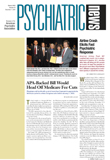APA is an organization that represents the profession of psychiatry: its members are psychiatrists, and APA’s positions are based on medical knowledge. Over the years it has been immensely successful in its advocacy, and this continues to the present day: Witness the historic parity legislation that at press time was moving from the U.S. Senate to the House of Representatives.
Unfortunately the percentage of American psychiatrists who belong to APA is declining, and the reasons for this are not necessarily known. The decline in membership is problematic because it diminishes our ability to represent the profession. This is so not only because we represent fewer psychiatrists, but also because we have fewer resources with which to do so. The organization is solvent and has reserves, but for those who are involved in allocating APA resources, it has become very difficult to create a balanced budget.
One answer is to reduce our scope of external activity. And budget cutting does so. One might argue that the end result will be an APA that is more streamlined and efficient at advocating for fundamental issues. The first items to go may be activities that are currently covered by other organizations. Another answer is to reduce the expenditures of our internal activity: to cut down on committees that are made up of experts on particular issues who volunteer their time, to use modern methods of communication that cut costs, and to rein in travel budgets.
One approach that would address both internal and external waste would be to consider our relationships with subspecialty psychiatric organizations for which there are APA units, such as those representing forensic, geriatric, child and adolescent, addiction, consultation-liaison, and academic psychiatrists. Membership in some of these organizations is contingent on APA membership, but that is not always the case. It makes no sense to have an independent subspecialty organization whose members all belong to APA and when APA has its own structure attending to the needs of that group of psychiatrists. I think that the structure and function of these organizations could be worked into that of APA to save resources and to share expertise. We all must work together for psychiatry.
For that matter, what is membership? What does it mean? APA’s central office is committed to making it easier to become a member, and there are tangible benefits from membership, from discounts on insurance and books to educational activities such as the annual meeting and valued periodicals such as the American Journal of Psychiatry, Psychiatric Services, and Psychiatric News.
Many describe APA as a “member organization,” the corollary of which is that membership is linearly related to the benefits perceived by psychiatrists. To me, those who live by that sword will die by that sword when our limits in resources force us to reduce, cut, streamline. Those who hold APA’s decision making hostage to the concept that any one decision will show a group of members that “APA does not care about you” have built upon an artificial distinction between the profession and the membership, with a focus on the latter.
We should do everything we can to entice nonmember psychiatrists to belong to APA, so that APA can represent the profession and do so without arguing over resources. In this time of national political and economic crises, psychiatry, its subspecialties, and the associations of other areas of medicine would all do well to come together.
And so, even if you are not “involved” in APA, you can help: bring a nonmember psychiatrist to APA, so he or she can join in the advocacy that will help patients and the profession in the long term. ▪

